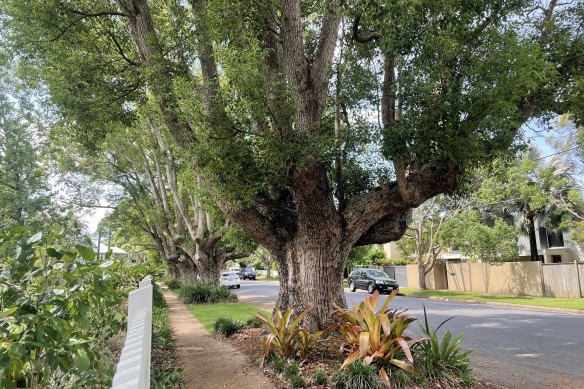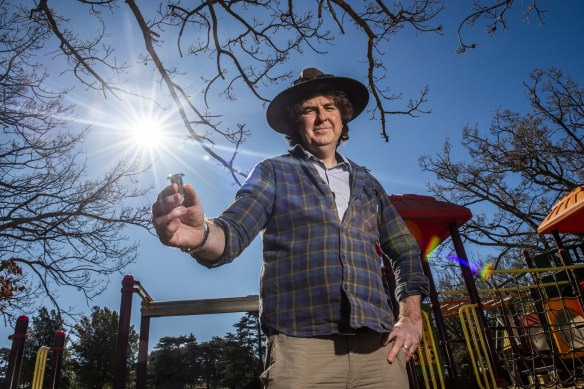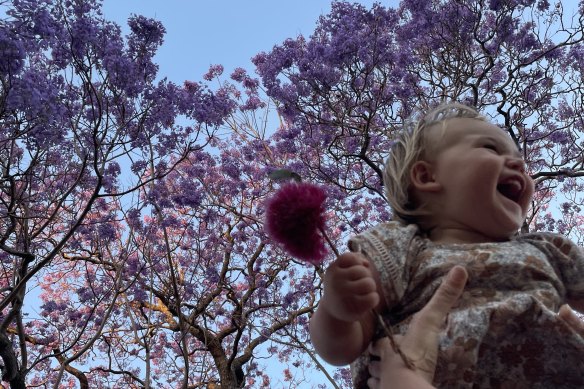From 210 site images surveyed for the study, 263 trees were identified as belonging to a footpath, with 48 species classified.
These included trees planted by local government, privately, and established trees left standing in newly developed suburban areas.

A well-shaded street, such as this one in Graceville, is defined by the presence of established, mature trees, says radiation expert Nathan Downs.Credit: Courtney Kruk
Leopard trees, camphor laurel, Indian beech, golden penda and cassia trees were among the top species providing shade along the city’s streets.
“But if you wanted to have the best trees [for shade], you’d probably be going for a ficus [fig] species,” Downs said.
“The problem with those is they’re very invasive, and the roots get into infrastructure.”
Above all, what defines a well-shaded street is the presence of established, mature trees. “The best time to plant a tree was 30 years ago, and the second-best time is today,” Downs said.

Radiation scientist Nathan Downs –pictured holding a whole-sky imaging device – has spent more than 20 years studying Queensland’s UV index. Credit: University of Southern Queensland
Over at the University of Queensland, research by Dorina Pojani and Sean Patton revealed a more critical outlook on shade provision across the city.
It counted trees in three Brisbane suburbs of varying average income levels, from low (Deagon) to middle (Riverhills) and higher (Parkinson). The results mirrored similar studies of urban environments around the world, finding differences in street cover predicated on income.
Loading
“The wealthier the suburb, the lusher it tends to be,” Pojani said. “It’s sort of a perverse outcome because in poorer suburbs, people need trees more because they’re more reliant on public transport.
“In wealthier suburbs, people have cars, and they don’t need to walk to transit as much.”
While Downs’ research focused on health outcomes associated with shade provision, Pojani and Patton approached tree cover from an amenity and accessibility perspective.
“We need trees for many reasons: they clean the air, they allow for better water circulation, they even allow animals to move through the city.
“In this instance, we have looked at street trees as providing transport infrastructure [and] providing shade for people to be able to get from their home to a bus stop.”
Brisbane’s bus stops can be particularly hostile, especially in summer. In 2020, Brisbane City Council surveyed residents to find out what they valued and what concerned them about street and park trees. Most said more shade trees at bus stops were needed.
So who is responsible for shade discrepancies?
“It’s a good question and something we’re researching more. But our speculation is that in wealthier suburbs, people are better organised and tend to be better educated,” Pojani said.

Dorina Pojani says while beautiful in spring, jacaranda trees don’t provide enough shade for Brisbane, which needs denser foliage.Credit: Courtney Kruk
“We know from other research that generally, [wealthy] people tend to dominate public participation activities in the city.
Loading
“People living in poorer suburbs work more jobs and have less time to contact council. They may not even have the confidence or human resources that wealthier suburbs do.”
Brisbane City Council chair of environment, parks and sustainability Tracy Davis said 79 per cent of residents live in a suburb with more than 20 per cent tree cover, and more than 11,000 street trees were planted last financial year.
While specific locations have not been decided, she said areas with less tree cover would be targeted for future street planting, and residents could contact council to ask for a tree on their verge.
“Council has been contacted 3372 times requesting street trees since 1 January 2023,” she said.
Downs has a simple explanation for why this matters.
“We want a city that’s liveable, and for me, a city that’s liveable is one that has good shade.”
Start the day with a summary of the most important and interesting stories, analysis and insights. Sign up for our Morning Edition newsletter.


